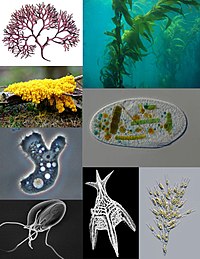
Photo from wikipedia
The taxon Protista was originally given by Ernst Haeckel in 1866 and included all unicellular organisms either prokaryotic or eukaryotic. In the modern view, the protists are eukaryotic organisms of… Click to show full abstract
The taxon Protista was originally given by Ernst Haeckel in 1866 and included all unicellular organisms either prokaryotic or eukaryotic. In the modern view, the protists are eukaryotic organisms of unicellular organization, and thus the term embraces classical protozoa, unicellular phototrophic organisms such as diatoms, and lower unicellular fungi (28). Due to the extreme diversity, the taxonomic system of protists has been revised several times according to new knowledge and concepts (11, 14, 65). Protists are currently recognized to be paraphyletic or even polyphyletic and to be widely distributed in all of the five major supergroups—like kingdoms— under the eukaryote classification proposed by the International Society of Protistologists (1). Protozoa are ‘animal-like’ protists that prey on other organisms. However, the term protozoa is no more (or at least much less) used due to the fact that some protozoa such as the euglenoids do photosynthesis as well. Different terms like ‘phagotrophic protists’, ‘heterotrophic protists’, and even just ‘protists’ are used to refer to protozoa depending on the context: the term ‘phagotrophic protists’ is used in this article. Among the members of protists in soil, phagotrophic protists are one of the groups that have been long and best studied. The composition and distribution of the phagotrophic protists (protozoan fauna) with different morphotypes—ciliates, flagellates, and amoeba—in soil was studied through a culture-based technique in 1920’s (55). Phagotrophic protists play a role in soil as bacterivores and their ecological significance had been demonstrated contemporaneously with the concept ‘microbial loop’ in the marine environments (6, 12, 13). Despite the long history of soil protozoology or protistology and the fact that the diversity of protists in soil would be as high as that in aquatic environments (7, 24), soil protists including phagotrophs are much less studied than their aquatic counterparts and this gap is increasing (26).
Journal Title: Microbes and Environments
Year Published: 2017
Link to full text (if available)
Share on Social Media: Sign Up to like & get
recommendations!